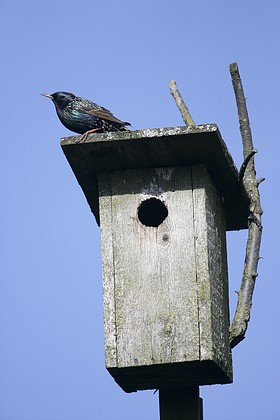Starling activity visible
Photo: Arne Ader
Translation: Liis
Starling
Starling Kuldnokk Sturnus vulgaris
Half a century ago building starling nest boxes was a regular spring activity in woodwork classes – there was roughly one model, or one corresponding to the available wood material. By now we find dozens of different models adapted to different bird species. This year schools try to revive the nice custom more widely: so we make life easier for many of our feathered friends and for bird friends there will be joy for years – nest boxes last for some ten years with a little care.
Starlings, who are extremely true to their nest-sites, were seen already in late February (there are only a few thousand winterers). The arrivals are mostly male birds who have nested earlier, and they at once go to their nest box of the previous year. As a rule they also stay there overnight, but clearing out trash starts after one or two weeks, then also the females may have started arriving. Of course much depends on the weather, the arrivals have had favourable winds from the south up to now. The ground is free from snow and the birds who inquisitively walk around on the yard grass find enough food – a few snowy days will not force them to migrate back southwards.
We will see how the life of starlings will progress in a week but anyone who is inspired to craft one or two nestboxes together with younger family members – you are not late at all. All new living space will be happily occupied. Around houses starlings nest even under asbestos cement roofing, ventilation openings and other strange places; believe me, the accommodation problem is urgent.
How will the starling summer turn out, roughly calculated? Breeding pairs are around a couple of hundred thousand, and as a rule nesting occurs only once in a summer. The average number of eggs in a nest is often 5 – so the next generation would be one million young starlings …
During some twenty years the number of nesting birds has remained at a relatively similar level, that is, a couple of hundred thousand nesting pairs.
What can we conclude? The increase in numbers per year by 2,5 during the nesting period only ensures the conservation of starling numbers for next year
Starling observations: LINK









